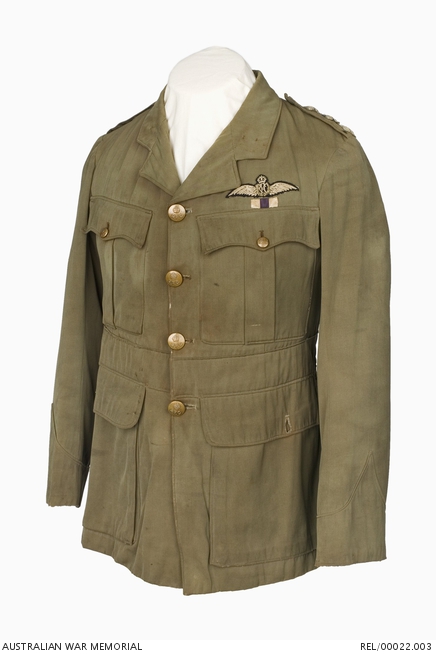| Place | Europe: Western Front |
|---|---|
| Accession Number | REL/00022.003 |
| Collection type | Heraldry |
| Object type | Uniform |
| Physical description | Cotton gabardine; Brass; Embroidery cotton thread; Silk |
| Maker |
Unknown |
| Place made | United Kingdom: England |
| Date made | c 1917 |
| Conflict |
First World War, 1914-1918 |
Officer's service dress tunic : Captain P G Taylor, Royal Flying Corps


Officer's khaki cotton gabardine unlined service dress tunic, with shoulder straps, lined with khaki wool, pleated breast pockets with triple pointed flaps, large expanding pockets over each hip with straight flaps, and pointed cuffs. There is a brass hook, to support a Sam Browne belt set into each side of the waist. The single breasted tunic fastens down the front with four brass 'R.F.C.' buttons (made by J R Gaunt, London) surmounted by a King's crown. The pockets and shoulder straps fasten with similar buttons of a smaller size. Each shoulder strap bears embroidered rank pips for captain. There are slits in each lapel where 'RFC' collar badges would have been placed, but these are missing. The left breast bears embroidered RFC pilot's wings above the pocket. Beneath the wings is a ribbon for the Military Cross awarded to Taylor in 1917. The sleeves only are lined with blue striped white cotton.
Patrick Gordon Taylor was born in Sydney in 1896. In 1915 he was appointed temporary lieutenant in 26 Battalion CMF, replacing a man who had joined the AIF. Keen to be on active service too, but rejected by the AIF, he travelled to England at his own expense to join the Royal Flying Corps. He was commissioned into the RFC on 12 August 1916 and trained as a pilot. He joined 66 Squadron, flying Sopwith Pup scouts. In July 1917 he was awarded the Military Cross and was promoted to captain, serving with 94 and 88 Squadrons. Taylor returned to Australia in 1919. During the 1920s he flew as a private pilot, completed an engineering course and studied air navigation. In 1933 and 1934 he was second pilot and navigator for Charles Kingsford Smith's Australia-New Zealand flights. He was navigator on Charles Ulm's Australia-England flights in 1933. Taylor and Kingsford Smith completed the first Australia to the US flight in 1934. In 1935 Taylor was Kingsford Smith's navigator for the King George V Jubilee airmail flight from Australia to New Zealand. Six hours into the flight the starboard engine failed and the aircraft turned back. When the oil pressure dropped on the port engine Taylor saved the flight by climbing out of the fuselage, edging along the engine connecting strut to collect oil from the starboard engine which he then transferred to the port engine. He repeated the process five times and the plane returned safely. For his courage and resourcefulness Taylor was awarded the Empire Gallantry Medal. In 1939 Taylor made the first flight from Western Australia to Kenya. During the Second World War he ferried flying-boats from the US to Australia. In 1943 he joined the RAAF but transferred to the RAF in 1944 ferrying aircraft from Canada to Britain. He flew an RAF Catalina on a survey flight from Bermuda to Sydney. In 1951 he flew from Australia to Chile in another Catalina. He published eight books on his flying experiences. He was knighted in 1954 and died in 1966.
Related information
Conflicts
Events
Units
Places
Subjects
Related Objects
- Summer service dress tunic : Captain P G Taylor, Royal Flying Corps
- Breeches : Captain P G Taylor, Royal Flying Corps
- Winter service dress tunic : Captain P G Taylor, Royal Flying Corps
- Winter service dress trousers : Captain P G Taylor, Royal Flying Corps
- Scarf : Captain P G Taylor, No. 66 Squadron, Royal Air Force
- Black Cat : Captain P G Taylor, No. 66 Squadron, Royal Flying Corps
- Pair of cut down flying boots : Captain P G Taylor, No. 66 Squadron, Royal Flying Corps
- Detachable collar : Lt P G Taylor, RFC